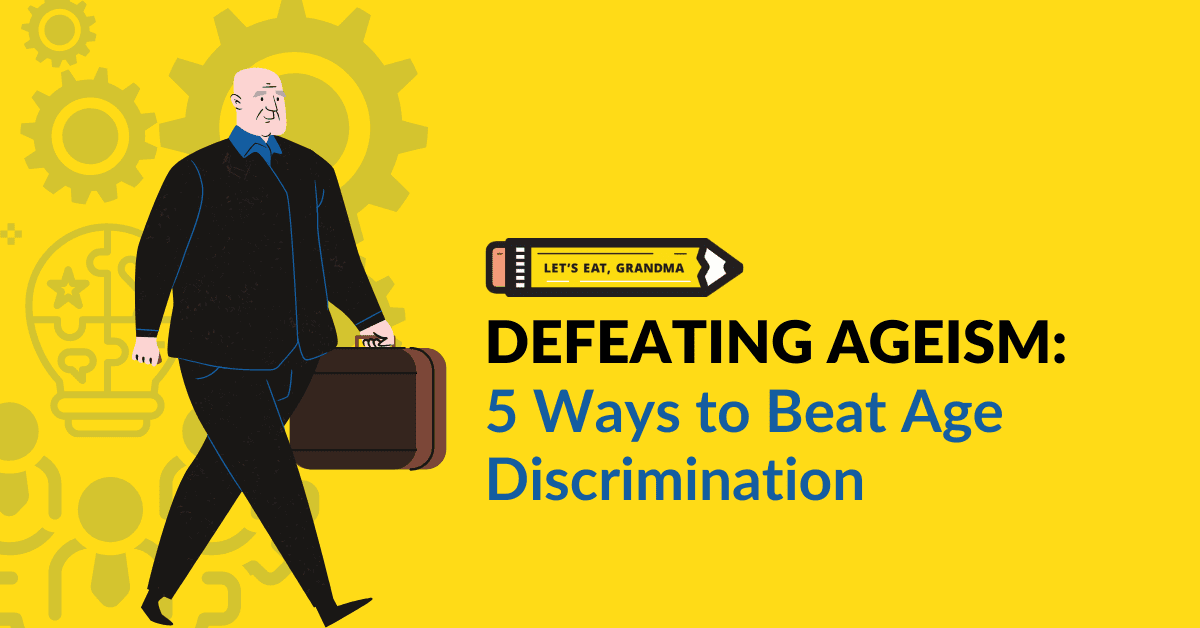Defeating Ageism, Part 1: 5 Ways to Avoid Age Discrimination on Your Job Applications

Are you an older adult about to start on a job search? Read on to find out how you can arm yourself against an unfortunate challenge: Ageism.
By: Grace Mitchell | Contributor for Let’s Eat, Grandma
Age discrimination, or ageism, is a huge issue in hiring today. While the Age Discrimination in Employment Act forbids employers from discriminating against people age 40 and older due to age, this unfair bias can be more difficult to prove during hiring versus on the job. In fact, 53% of baby boomers say they’ve faced age discrimination during the hiring process.
Many older adults transition into “bridge jobs” or “semi-retirement” later in their careers, but our current economic climate has forced many more to go looking for work. With so many older adults seeking employment (and with employers discriminating against even those on the lower end of older adult), age discrimination in hiring impacts more lives than ever before.
Ready for more job search help?
Sign up for a free Senior Writer Resume Critique to see what's holding you back from landing interviews. One of our top professional resume writers will give you personalized feedback on the top 3 items you can improve based on our expert practices!
In an article with SHRM, Michael S. North, an assistant professor of management and organizations at New York University’s Stern School of Business says, “The problem with ageism is that it’s really sneaky, it’s subtle. Age discrimination is more prevalent than people think.”
A Prevalent Problem

Ageism is still an issue in the hiring process, even though government regulations have been introduced to reduce it. Photo by LinkedIn Sales Solutions on Unsplash
A 2017 study that sent over 40,000 resumes of fictional applicants with similar skillsets but different age ranges to low-level job postings found that older Americans received fewer callbacks than younger Americans. Adults aged 64 to 66 received fewer callbacks than those aged 49 to 51, and older women received even fewer than older men. Even older adults who were not near the retirement age still received fewer callbacks than those under 40.
Age discrimination can also be seen in coded language that employers use in job descriptions. For example, a job description may call for “energetic,” “digital native,” or “dynamic” new hires when the employer really means “young.” Some employers, reject older applicants on what they cite as a lack of “cultural fit.” Or they try to prevent older applicants from applying at all, targeting job ads to display only to people within a certain age demographic (a practice no longer permitted on Facebook after recent age discrimination lawsuit settlements).
Fortunately for the savvy job seeker, these discriminatory practices become more difficult for employers to mask later in the application process, according to economics professor and hiring researcher David Neumark. Getting to the interview stage also provides “a chance the employer may notice traits that outweigh age bias,” he says. Employers who demonstrate provable bias in interviews have faced numerous lawsuits, with more expected on the horizon.
5 Ways to Prevent Age Discrimination on Your Applications
Removing traces of your age in your resume can help you get your foot in the door. If you are an older adult looking for work, consider these 5 ways to disguise your age on your resume:
1. Remove old positions
Your resume should be as succinct as possible. In general, it’s best to only focus on the past 10-15 years of your career. Unless the older positions are relevant to the job you’re applying for, they probably don’t belong on your resume. If they are relevant, you may want to consider an early career section, coming up in the next step. (And while you’re at it, don’t forget to erase those old positions from your LinkedIn profile, too!)
2. Remove education and some job dates
Unless the job application specifically asks for your graduation dates, you don’t need to mention them, and you can leave these dates off your resume as well. While industry standards shift over time, degrees don’t have expiration dates.
Similarly, including an “Early Career” section in your resume gives you the freedom to include those 15+ year-old relevant positions without listing dates.
3. Consider upskilling with certifications in modern skills
Adding relevant certifications is always a good bet, but adding skills that didn’t even exist two years ago gives you the added benefit of matching that “dynamic” feel hiring managers are looking for.
Platforms like LinkedIn and Udemy offer thousands of professional development courses for different industries, as well as “soft skill” courses. (And depending on where you live, you may be able to access Udemy for free with your public library card). If you just want to dip your toes in a skill before pursuing a course, there are plenty of free tools for modern skills like video editing, too.
Now put those skills where hiring managers can see them! Not only will they mark you as someone who knows current industry trends, they’ll also set you apart from fellow applicants who haven’t gone that extra mile.
4. Update dated email addresses and remove dated technologies

Showcasing mastery of current technologies will position you as a contemporary candidate. Photo by Vincent Botta on Unsplash
5. Update your resume design
Like industry standards, preferences for resume formatting have changed over time. The Objective Statement gives way to the Summary of Qualifications (good riddance, we say!), and designs that once showcased your computer skills may leave modern hiring managers wondering if you’ve been left behind.
If your resume design has been stagnant for a few years, it’s time to change things up! Choose an ATS-friendly design that showcases your skills. Some websites offer fancy “modern” templates, but we recommend avoiding these. Many aren’t ATS-friendly, don’t give you the space to input your experience, and favor pizzazz over content. Instead, use simple formatting and white space that give you room to highlight your summary of qualifications, relevant professional experience, skills, and education.
Resume writing can be difficult to navigate when prospective employers’ biases may already be stacked against you. However, by removing dated content and adding in current skills and designs, your resume can highlight you as the capable career-changer we already know you are.
Ready for more job search help?
Sign up for a free Senior Writer Resume Critique to see what's holding you back from landing interviews. One of our top professional resume writers will give you personalized feedback on the top 3 items you can improve based on our expert practices!
Better Resume.
Satisfying Career.
Happier You.
